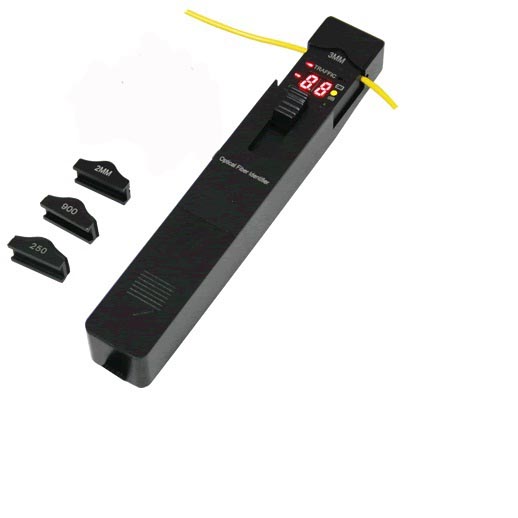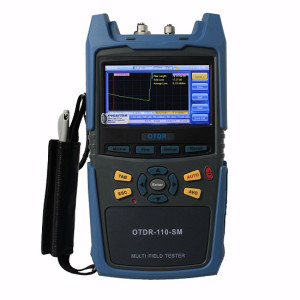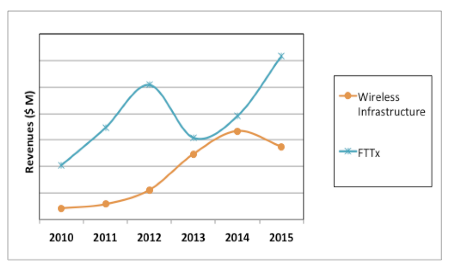Unlike sources and power meters, which measure the loss of the fibre optic cable plant directly, the OTDR works indirectly. The source and meter duplicate the transmitter and receiver of the fibre optic transmission link, so the measurement correlates well with actual system loss. The OTDR, however, uses unique phenomena of fibre to imply loss.
The biggest factor in optical fibre loss is scattering. It is like billiard balls bouncing off each other, but occurs on an atomic level between photons (particles of light) and atoms or molecules. If you have ever noticed the beam of a flashlight shining through foggy or smokey air, you have seen scattering. Scattering is very sensitive to the colour of the light, so as the wavelength of the light gets longer, toward the red end of the spectrum, the scattering gets less. Very much less in fact, by a factor of the wavelength to the fourth power – that’s squared-squared. Double the wavelength and you cut the scattering by sixteen times!
Archive for April 2016
How does an OTDR work?
Market Growth Hinges on the Adoption of Next Generation Technologies
Demand for optical connectivity remains strong despite a declining capex of telecom network operators and lower than expected growth in infrastructure spending by cloud companies. Optics takes on a larger share of the connectivity as data rates go up. Increasing complexity of high-speed optics translates to higher product pricing, boosting revenues of component suppliers, while offering cost reductions to end users in terms of dollars per Gigabit of bandwidth.
The spending of the 15 leading network operators is set to drop in 2016. The operators’ guidance on their 4Q15 earnings calls means the Far East will spend less in 2016 and in the case of the Chinese operators, significantly less. The analytics forecast that capex will be down 7% to $178 billion dollars in 2016.
Read more
How Does a Fiber Identifier Work?

Simply put, the fiber identifier uses a super low insertion loss local detection method of macro-bending. This allows for detection of the optical signals during installation and maintenance without disconnecting the fiber or interrupting the traiffic signal.
This macro-bending method eliminates the need to open the optical fiber at the splice point reducing the probability of interrupting service to your customer.
SYOPTEK’S OFI-201 Optical Fiber Identifier is an essential installation and maintenance instrument. By inserting the fiber into its adapter to avoid the opening of the fiber at the splice point for identification and thus avoids the interruptiion of the service. In the presence of traffic, the intermittently audible tone is activated. This optical fiber identifier also allows relative core power display and identification of the 270 Hz, 1k Hz, and 2k Hz frequencies. When they are used to detect the frequency, the continuously audible tone is activated. There are four adapter heads available: Φ0.25, Φ0.9, Φ2.0, Φ3.0
Is OTDR testing necessary for premise cabling?
 While there has been some “buzz” about Optical Time Domain Reflectometer(OTDR)testing for premises cabling since the publication of TSB-140, Additional Guidelines for Field-Testing Length, Loss and Polarity of Optical Fiber Cabling Systems, many agree that the test is usually not necessary for the relatively short links found in a customer-owned network, and may merely add unnecessary expense and complexity.
While there has been some “buzz” about Optical Time Domain Reflectometer(OTDR)testing for premises cabling since the publication of TSB-140, Additional Guidelines for Field-Testing Length, Loss and Polarity of Optical Fiber Cabling Systems, many agree that the test is usually not necessary for the relatively short links found in a customer-owned network, and may merely add unnecessary expense and complexity.
When testing an optical premises network, the key measurement criterion is insertion loss, or attenuation. This is effectively measured by using a power meter and light source. If the attenuation is within the limits of the allotted power budget, the system will work. OTDRs measure Raleigh backscatter, not absolute loss.
Supporters of OTDR testing in the premise environment believe that testing with an OTDR can help identify microbends that could potentially cause a problem; as well as help document the system for future verification. However, visual inspection is usually the best way to locate breaks or bends. While there may be some minor advantages in performing OTDR testing on premise cabling, the added cost usually outweighs the benefits.
The global market for FTTx gptical components and modules will set for a second wave of growth in 2016-2020.

Network operators in Hong Kong, Japan and Korea have connected close to 100% of their domestic residents with fiber and are starting to offer 1G and even 10G speeds. For a selected few customers, docking their yachts in Hong Kong’s harbors, 1 Gbps fiber to the yacht (FTTy) connections are now available. However today, 1G connectivity in itself is not a luxury. According to Amano-san of NTT, 1 Gbps connectivity today costs customers in Japan less than 10Mbps service did back in 2001. That is a factor of 100 improvement in speed and cost per Gbps over the last 15 years!
China leads the world in the total number of FTTx subscribers, which is expected to exceed 100 million by the end of 2015. The Chinese government’s latest plan calls for doubling the connectivity speed by the end of 2015, while reducing the end user’s cost by 40%. India and Indonesia are just starting to deploy FTTx, as their governments have approved very ambitious plans to bring fiber connectivity to even the smallest and most remote villages. “FTTz” as mentioned in the title, is not a real term, but it symbolizes extending fiber to every last resident of the region.
Read more
Is Silicon Photonics a disruptive technology ?

Many in the industry have predicted that Silicon Photonics (SiP) will enable inexpensive, mass produced optical connectivity, radically changing the optical components and modules industry. Our analysis suggests this will not happen in the next 5 years, but sales of SiP-based optical products may reach $1 billion by 2020, accounting for about 10% of the market.
As often happens with new technologies, product sales are starting to ramp up just as industry expectations start to fade, as illustrated in Figure (Typical trend for cross-correlation between industry expectation for new technologies and product sales) above.
It seems clear that several SiP suppliers demonstrated that this technology works. However, it is up to the manufacturing engineers and business managers of these suppliers to show that SiP products can be made in high volume at a competitive cost and generate profits to fund development of next generation products.
Read more
